In this report I address experiences I had guiding and fishing on the Ranch during the last week of August and the first two weeks of September. Until the period between 27 August and 14 September, Ranch fishing had been sub-par. We had good fishing—particularly with Flavs in the early summer, honey ants in the late summer, and pale morning duns at several times during the season; but, low water levels in June, variations in water releases during most of July, and cool, wet weather in August produced many poor days.
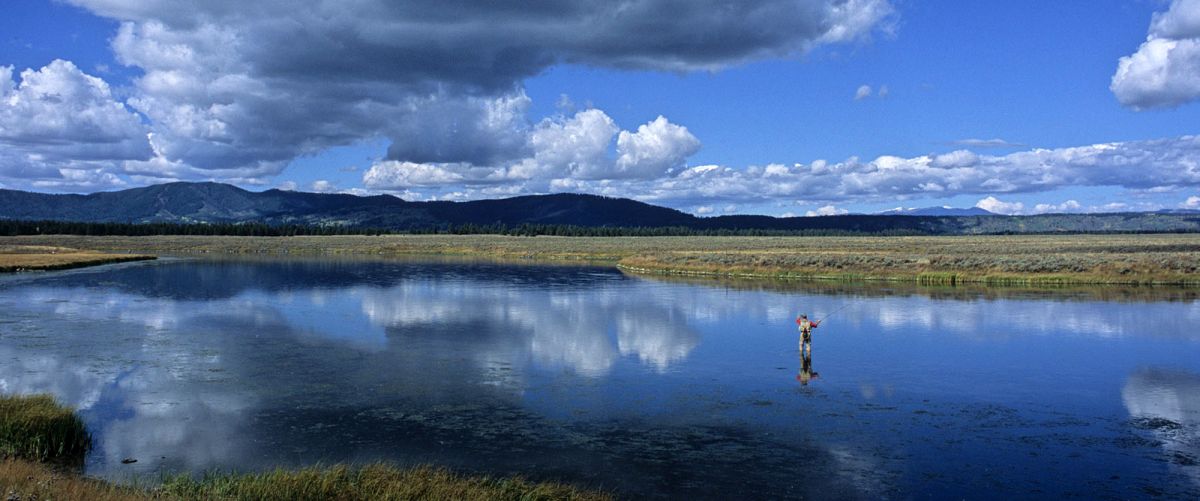 The conditions had a particularly negative effect on our spinner fishing. In 2013, no less than 25 percent of the good fish my clients and I landed were taken on mayfly spinner patterns. This year, that number dropped to 13.5 percent. (I shall not continue to use the word "good” to define the Ranch fish we hooked. We do not target, nor do I document small trout we hook by mistake.)
The conditions had a particularly negative effect on our spinner fishing. In 2013, no less than 25 percent of the good fish my clients and I landed were taken on mayfly spinner patterns. This year, that number dropped to 13.5 percent. (I shall not continue to use the word "good” to define the Ranch fish we hooked. We do not target, nor do I document small trout we hook by mistake.)
The superb fishing began on 27 August when I took a friend, Dave Lombardi, to The Avenue of the Giants. At 10, fish began to rise actively to flying black ants. When it stopped at 3 PM we had hooked 23 and landed 10. We both lost great fish in the heavy weeds, but landed several 20 and 21 inch brutes. We took them on black flying ants, in sizes 16 and 18, and a Harrop size 16 dark honey ant. If you got a decent drift, the big rainbows ate your ant.
30 August was another epic day. I was guiding two skilled anglers from New Zealand— one of whom guides on the South Island. We, too, were in the Avenue of the Giants. Our day started in a cold, 45 degree, rain. The weather deteriorated when the wind came up and we got hail. I said, "You know I heard some cows were killed by hail in eastern Montana.” The two tough Kiwis laughed. When our hands were no longer capable of tying flies on our tippets, we headed for TroutHunter to seek heat, warm food, and wool clothes. I said, "You are going to think I am nuts, but I think we could have good bugs later.” The guide said, "Good on you, mate.” (I think that means, "Good suggestion partner—lets go for it!) We left TroutHunter at 2PM, and headed into the storm.
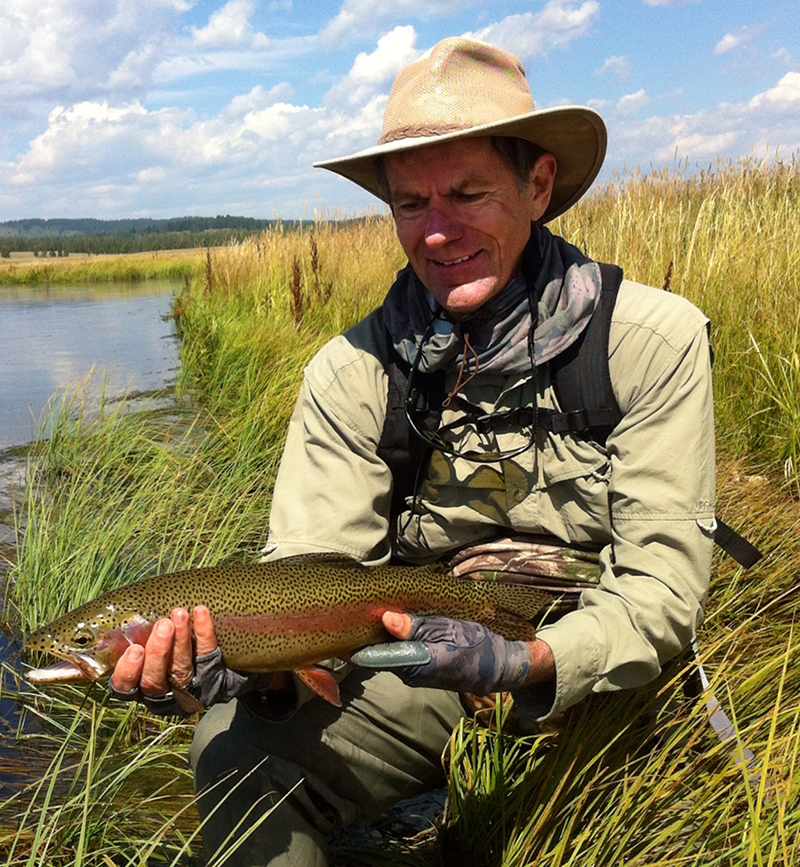
When the Kiwis said "enough” at 5:30, they had hooked 22 and landed 12. The two anglers took about a third of their fish on black flying ants—including several tiny size 24s— a third on size 22, blue wing olives, and another third on size 16 mahoganies. As soon as one of the anglers landed a fish or lost one, it was rare he would have to move to find another target.
One of the neatest aspects of the day was how excited the Kiwis got about our fish. There are huge trout in New Zealand. After teasing from his mate, the Kiwi guide agreed to show me a picture of a 22 pound rainbow he took, on a size 12 pheasant tail. The incredible fish was 34 inches long and had a girth of 28 inches. Trust me, New Zealand trout are also great fighters. My comment is not based on fishing there for a week. I convinced a University Dean to allow me to spend six months of a year’s sabbatical in the country. I left the Islands in awe of the trout. I was, candidly, shocked that the two fine Kiwi anglers were so impressed by our fish that they screamed, and occasionally cursed, with respect when playing them. I loved it.
The Kiwis were stunned by the aquatic insects on the Ranch. They took pictures of the blue wing olives that virtually covered the wide, flat water. Their respect for our fish, insects, and the fishery in general was immensely gratifying.
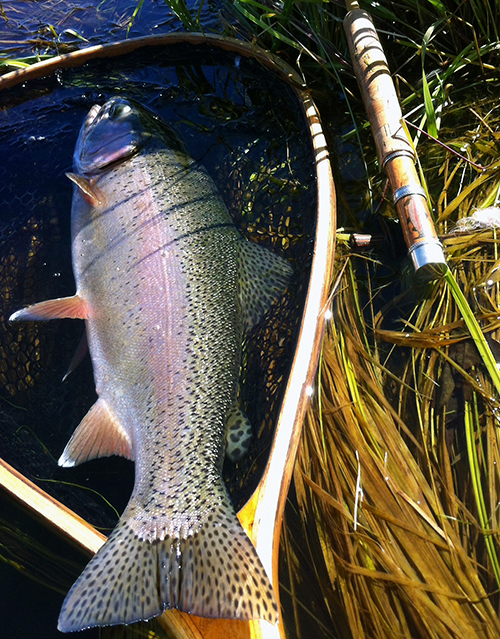 There were no other days that matched the two I have just described; however, there was consistently good fishing. I have said that: "three fish in the net is an excellent Ranch day.” We averaged over three fish a day for each of the 17 days I fished or guided. We invested a total of 137 hours and hooked 92 fish; hence, we hooked a rainbow fish every 1.48 hours we were on the water.) To put that number in perspective, in my most productive longer period (consisting of 185 hours) of fishing the Ranch I hooked a big rainbow every 1.6 hours. I accomplished that with the rod that you see in the picture to left. It is a four piece, 8½ foot, 5 weight, cane rod made by Tim Anderson. It is completely "hollowed” to the end of its fine tip. After two years of fishing it, I believe it is the most efficient Ranch rod I have ever used. (The comment is a profound complement because I own a Per Brandin 8 foot, 3 inch, 4 weight spliced-joint quad, cane rod that is the finest 4 weight rod I have ever cast.)
There were no other days that matched the two I have just described; however, there was consistently good fishing. I have said that: "three fish in the net is an excellent Ranch day.” We averaged over three fish a day for each of the 17 days I fished or guided. We invested a total of 137 hours and hooked 92 fish; hence, we hooked a rainbow fish every 1.48 hours we were on the water.) To put that number in perspective, in my most productive longer period (consisting of 185 hours) of fishing the Ranch I hooked a big rainbow every 1.6 hours. I accomplished that with the rod that you see in the picture to left. It is a four piece, 8½ foot, 5 weight, cane rod made by Tim Anderson. It is completely "hollowed” to the end of its fine tip. After two years of fishing it, I believe it is the most efficient Ranch rod I have ever used. (The comment is a profound complement because I own a Per Brandin 8 foot, 3 inch, 4 weight spliced-joint quad, cane rod that is the finest 4 weight rod I have ever cast.)
In the context of calculating my "Ranch fishing hours,” the clock "starts running” as soon as I leave my car. If I am fishing Bonefish, or a location of comparable distance from a parking lot, I will invest over an hour in the round trip. On some days, I make the walk more than once. That adds a huge amount of time when I am not casting to my "fishing” hours.)
My clients deserve credit for our success in hooking fish. Dave Lombardi, Daryl Paskell, Mark Brown, Ted Nolan, and Chris Capozzi never complained about the poor weather, the long walks, or the enervating wading in the heavy weeds. They consistently fished with intensity and determination.
I fished alone on eleven of the days, guided on four, and took friends out on two. My days alone average 4.5 hours. My four days of guiding averaged 8.5 hours in length. The two days I took friends out on non guided trips averaged 7 hours.
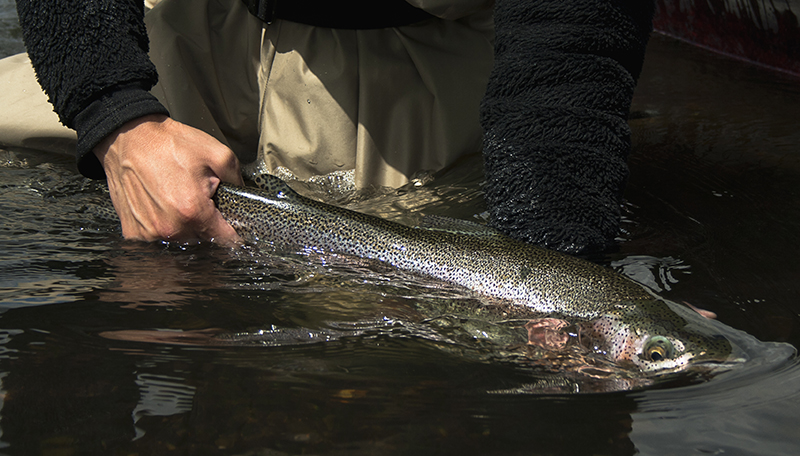
We landed 55 of the 92 fish we hooked. Twenty-one of the fifty-five fish were 20 inches or longer in length. (To have 38 percent of your fish—all landed on dry flies—be at least twenty inches in length speaks to the special nature of the Harriman Ranch fishery.) The largest fish was a 23 inch male taken on a hopper by Dave Lombardi.
Our rainbows are strong, fast, spectacular jumpers, and have remarkable endurance. Our current fish are particularly fit. In the 1980’s, I took the time to take measurements of the "depth” of our fish. I was very impressed that the average 20 to 22 inch fish was about 4.5 inches "deep”— when measured in a straight line, from the top of the back to the bottom of belly. I thought our 2014 fish looked deeper and thicker than the fish I had measured from the 80s. They were. I measured several fish and found that they averaged a full 5 inches in depth.
In a catch and release fishery that maintains wild trout, the quality of the fight of a fish is related to how many times it has been caught. The poor fishing during much of July and early August resulted in modest pressure being imposed on the rainbows. I found significantly fewer hook scars on the fish than I did in 2013. During our 17 days, it was rare not to have fish fight with shocking speed and strength. I regularly hear clients say, "That is the largest fish that I have landed on a dry fly.” This year, it was fun to have more than one say, "That is the first fish I have ever hooked on a small dry fly that took me well into my backing!”
I am seeing healthier fish than in other years. In the 80s and 90s I would find a significant number of fish with sores, or scabs, on their gill plates; moreover, many, particularly large males, were thin. This year, only one fish had a scar on its gill plates, and 54 out of the 55 fish we landed were heavy and deep. I do not have an answer as to why, but I am confident we are dealing with a population of rainbows that is as healthy as any I have seen in my 32 full summers on the Ranch.
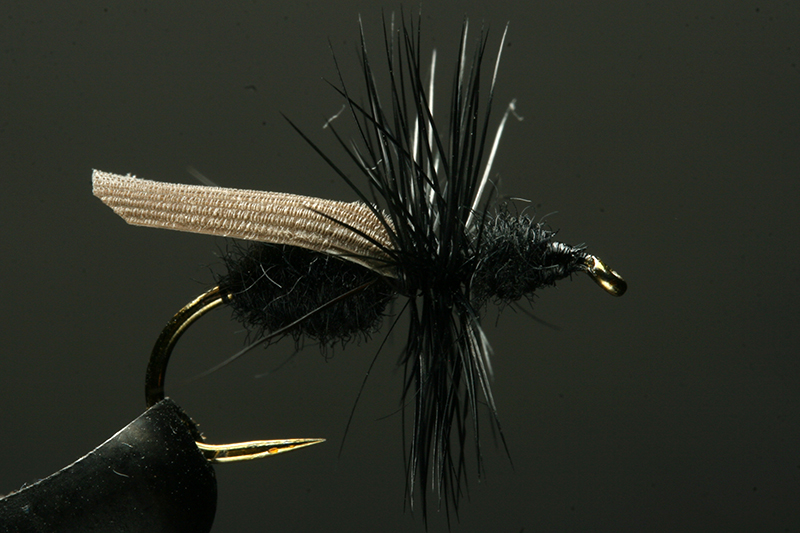 Five flies were used to take the 55 fish we landed. They were size 16, 18, and 24 Harrop flying black ants, size 16 Harrop dark honey ants, size 22 Harrop blue wing olive cripples, size 16 Brad Smith mahogany cripples, and size 8 and 12 foam ants from the TroutHunter bins. All my guide trips were walk / wades.
Five flies were used to take the 55 fish we landed. They were size 16, 18, and 24 Harrop flying black ants, size 16 Harrop dark honey ants, size 22 Harrop blue wing olive cripples, size 16 Brad Smith mahogany cripples, and size 8 and 12 foam ants from the TroutHunter bins. All my guide trips were walk / wades.
While my two epic days with clients were set in the Avenue of the Giants, we also took fish in the rapids below the Log Jam, at: the Bay of Pigs, The Third Fence, The Hopper Bank, The Small Grassy Island, The Meat Hole, Bonefish Flats, The Islands, Trico Bay, Lost Island Turn, The Rapids Above the Stock Bridge, The Back Channels, The Flats Above the Channels, The First Channel, The Flats Below Osborne Springs, and Pale Morning Dun Bay.
Our hooked to land ratio—55 of 92 fish hooked—was 59.7 percent. It is surprising we achieved that number with the heavy weeds. Last year, when we had comparable weeds in August and September, the percentage of Ranch fish landed by my clients and me was well below 59 percent. While the differences may have been due to good luck and the fact we were relaxed by having so many shots at fish, I think we learned some things that made us more effective landing fish. First, I began to use heavier tippet material. I had been a "6X only” guy for smaller dry flies. This year—thanks to the wise council provided by many skilled younger guides upon whom I often depend for advice—I began to use the 5.5 TroutHunter fluorocarbon tippet material for small flies, and never fished hoppers with less than the 4.5 TroutHunter fluorocarbon. I am confident the heavier tippets helped us.
 There were several techniques we used in the heavy weeds. First, I tried to get directly downstream of a hooked fish. Some fish were difficult to get below; however, when I did, fewer weeds would get on the line. A second technique was to take weeds off the line when fighting the fish. I know some clients were sure if I touched the line I would break the fish off. I don’t know how many times I took weeds off a client’s line, but I never had a fish break off when I was doing it. When I fished alone, I put my rod down, with care, in the water, and "walked up the line” to take weeds off. I did break one fish off, but I probably landed ten using the technique. If there were only a few weeds off the line, I did not "walk up the line,” but if the clump was big enough to pull the line down to the water, or was sliding toward the fish, I would take the chance. If a fish drove into, or under, the weeds—which many did after making several long runs— I keep constant pressure on the rainbow from downstream. If you were patient, he would lose strength, and come back to you. On a couple of occasions, I netted fish that were trapped in weeds, and visible to me, near the surface.
There were several techniques we used in the heavy weeds. First, I tried to get directly downstream of a hooked fish. Some fish were difficult to get below; however, when I did, fewer weeds would get on the line. A second technique was to take weeds off the line when fighting the fish. I know some clients were sure if I touched the line I would break the fish off. I don’t know how many times I took weeds off a client’s line, but I never had a fish break off when I was doing it. When I fished alone, I put my rod down, with care, in the water, and "walked up the line” to take weeds off. I did break one fish off, but I probably landed ten using the technique. If there were only a few weeds off the line, I did not "walk up the line,” but if the clump was big enough to pull the line down to the water, or was sliding toward the fish, I would take the chance. If a fish drove into, or under, the weeds—which many did after making several long runs— I keep constant pressure on the rainbow from downstream. If you were patient, he would lose strength, and come back to you. On a couple of occasions, I netted fish that were trapped in weeds, and visible to me, near the surface.
One afternoon, I hooked a strong fish that ran under a solid mat of weeds. My estimate was the fish went at least ten yards under the mat. I thought I had no chance of extracting him. Thinking there was nothing else to do, I put significant lateral pressure on the rainbow. At first, there was no give; however, after what was probably no more than two minutes, I felt the fish come toward me. The constant pressure eventually extracted the fish. I concluded that the water under the solid mat of weeds must have been relatively free of weeds.
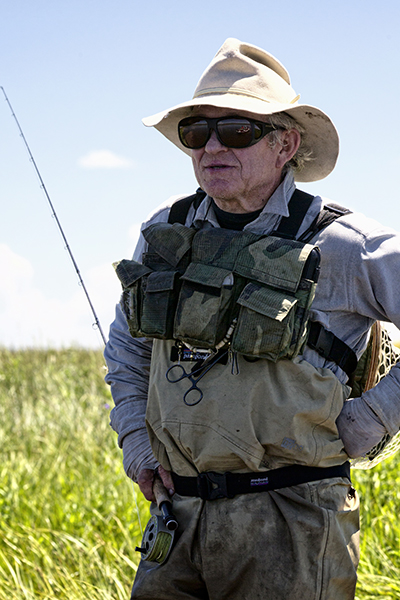 I have suggested that clients come to fish the Ranch in June, the first two weeks of July, or the first three weeks of August. As a result of the fishing I have just described, I am ready to argue the last week of August and the first two weeks of September could be as good, or better, than any of the other periods. I hope this report stimulates some anticipation and day-dreaming.
I have suggested that clients come to fish the Ranch in June, the first two weeks of July, or the first three weeks of August. As a result of the fishing I have just described, I am ready to argue the last week of August and the first two weeks of September could be as good, or better, than any of the other periods. I hope this report stimulates some anticipation and day-dreaming.
John McDaniel is the author of "Fly Fishing the Harriman Ranch of the Henry's Fork of the Snake River Lessons Learned and Friends Made Sight Fishing to Selective Trout" as well as a remarkably detailed fishing map of the Ranch.
He is a wade fishing guide specializing in the challenging Harriman Ranch. Please call the shop at 208.558.9900 to set up a day on the Ranch with John.

1 Comment
Gary
Those are some great looking fish! Great article sounds like a great experience during them weeks